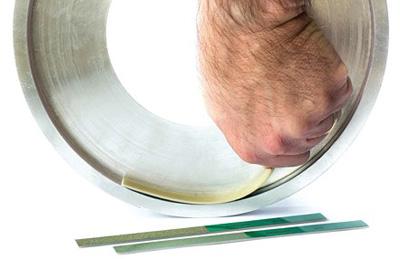
Titan Tool Supply Inc. announces the introduction of its new line of flexible diamond finishing files for the removal of material in the maintenance of extrusion dies, aircraft components, and other difficult-to-reach areas for conventional means of finishing. They are designed for working with materials such as tungsten carbide, stone and marble, composite materials, industrial ceramics, reinforced plastics, fiberglass, ferrite materials, nonferrous materials, rubber, and glass.
“Super Flex” files are extremely long, measuring 7.08" (180mm) in length, 0.50" (12.7mm) in width and are extra flexible for use in narrow slots where access is difficult. Despite the thinness, they are strong, according to the company, because they are constructed of metal. Plated length of Super Flex is 1.97" (50mm), and they are available in nine models with thicknesses (after plating) ranging from 0.006" (0.17mm) to 0.035” (0.9mm) and grit sizes of 1200 (two models), 500/600 (two models), 270/325 (two models), 170/200 (two models) and 120/140 (one model).
The unique new Composite Flex Files are the first files to be made on a non-steel based blank, Titan Tool states. They are constructed of a special lightweight, composite material for strength and flexibility. Its dot matrix plating enhances removal of the filed material to provide a superior surface finish. With a length of 6.70" (170mm), width of 0.55" (14mm), thickness of 0.07" (1.7mm) and plated length of 3.45" (88mm), they are available in three models with grit sizes of 325/400, 200/230, and 120/140.
Contact Details
Related Glossary Terms
- ceramics
ceramics
Cutting tool materials based on aluminum oxide and silicon nitride. Ceramic tools can withstand higher cutting speeds than cemented carbide tools when machining hardened steels, cast irons and high-temperature alloys.
- extrusion
extrusion
Conversion of an ingot or billet into lengths of uniform cross section by forcing metal to flow plastically through a die orifice.
- ferrite
ferrite
Solid solution of one or more elements in body-centered cubic iron. Unless otherwise designated, for instance, as chromium ferrite, the solute is generally assumed to be carbon. On an equilibrium diagram, there are two ferrite regions separated by an austenite area. The lower area is alpha ferrite and the upper area is delta ferrite. If there is no designation, alpha ferrite is assumed. Not more than 0.04 percent carbon can be dissolved in alpha iron. Ferrite is stable below 1,670º F (910º C); it is soft, highly ductile, and magnetic. Ferrite loses its magnetic property above 1,414º F (768º C).
- tungsten carbide ( WC)
tungsten carbide ( WC)
Intermetallic compound consisting of equal parts, by atomic weight, of tungsten and carbon. Sometimes tungsten carbide is used in reference to the cemented tungsten carbide material with cobalt added and/or with titanium carbide or tantalum carbide added. Thus, the tungsten carbide may be used to refer to pure tungsten carbide as well as co-bonded tungsten carbide, which may or may not contain added titanium carbide and/or tantalum carbide.
